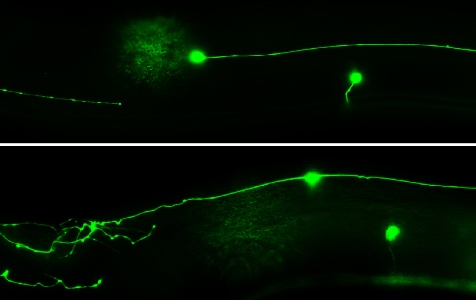 Neurons lacking DIP-2 (bottom) have a different shape than normal neurons (top). Courtesy of Nathaniel Noblett and Antonio ColavitaNeurons are among the most long-lived and carefully-shaped cells in the human body, with long axons that send signals to different parts of the body. Unlike other cells that can be replaced when needed, neurons tend to be around for a long time, sometimes over an entire lifetime, and therefore have evolved ways to maintain their complex shapes. New research led by Dr. Antonio Colavita and Dr. Yishi Jin shows for the first time that the mechanisms that keep axons so stable over time may share common features with those that interfere with their ability to regenerate after an injury. Using the microscopic worm C. elegans, they show that a highly conserved protein called DIP-2 is involved in preventing rogue shape changes, like extra branches, in normal aging neurons and in neurons that have undergone an axon injury. These findings published in the Journal of Cell Biology (JCB) may lead to new ways to promote axon regeneration in neurons damaged by disease or injury.
Neurons lacking DIP-2 (bottom) have a different shape than normal neurons (top). Courtesy of Nathaniel Noblett and Antonio ColavitaNeurons are among the most long-lived and carefully-shaped cells in the human body, with long axons that send signals to different parts of the body. Unlike other cells that can be replaced when needed, neurons tend to be around for a long time, sometimes over an entire lifetime, and therefore have evolved ways to maintain their complex shapes. New research led by Dr. Antonio Colavita and Dr. Yishi Jin shows for the first time that the mechanisms that keep axons so stable over time may share common features with those that interfere with their ability to regenerate after an injury. Using the microscopic worm C. elegans, they show that a highly conserved protein called DIP-2 is involved in preventing rogue shape changes, like extra branches, in normal aging neurons and in neurons that have undergone an axon injury. These findings published in the Journal of Cell Biology (JCB) may lead to new ways to promote axon regeneration in neurons damaged by disease or injury.
Authors: Nathaniel Noblett, Zilu Wu, Zhao Hua Ding, Seungmee Park, Tony Roenspies, Stephane Flibotte, Andrew D. Chisholm, Yishi Jin, Antonio Colavita
Funders: Canadian Institutes of Health Research, Natural Sciences and Engineering Research Council of Canada, National Institutes of Health, The Ottawa Hospital Foundation
The Ottawa Hospital: Inspired by research. Driven by compassion
The Ottawa Hospital is one of Canada’s largest learning and research hospitals with over 1,100 beds, approximately 12,000 staff and an annual budget of over $1.2 billion. Our focus on research and learning helps us develop new and innovative ways to treat patients and improve care. As a multi-campus hospital, affiliated with the University of Ottawa, we deliver specialized care to the Eastern Ontario region, but our techniques and research discoveries are adopted around the world. We engage the community at all levels to support our vision for better patient care. See www.ohri.ca for more information about research at The Ottawa Hospital.
University of Ottawa: —A crossroads of cultures and ideas
The University of Ottawa is home to over 50,000 students, faculty and staff, who live, work and study in both French and English. Our campus is a crossroads of cultures and ideas, where bold minds come together to inspire game-changing ideas. We are one of Canada’s top 10 research universities—our professors and researchers explore new approaches to today’s challenges. One of a handful of Canadian universities ranked among the top 200 in the world, we attract exceptional thinkers and welcome diverse perspectives from across the globe. www.uottawa.ca
Media Contact
Jennifer Ganton
Director, Communications and Public Relations
Ottawa Hospital Research Institute
Office: 613-798-5555 x 73325
Cell: 613-614-5253
jganton@ohri.ca
